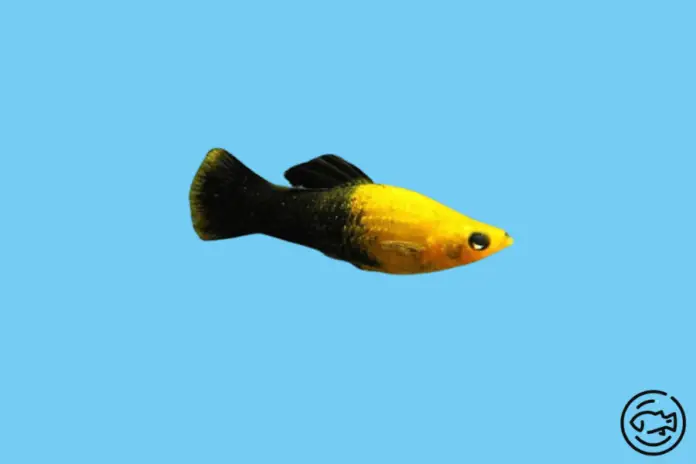One of the most prevalent and sought-after molly types in the aquarium business is the Gold Dust Molly (Poecilia sphenops).
Aquarists have kept and raised this species a lot because it is easy to care for, and the males tend to have rich & golden colors that are passed on to their offspring through genetics.
As a member of the family Poeciliidae, the gold dust molly is a vibrantly colored freshwater fish that stands out from other mollies due to its black dots on the dorsal fin and lack of markings on the flanks.
The keeping of mollies as pets has been popular since at least 1899. However, new types didn’t develop until the 1920s.
The males of the species Poecilia sphenops will only grow to 3 inches long, while the females will grow to 4 inches long.
Since they are so popular in the hobby, the wild blue-yellow or red fins have been used to make a lot of different colors and fin shapes.
Origin And Descriptions

In Panama, they grow gold dust molly.
These mollies do not cause any trouble and prefer to spend their time in the group. They belong to the genus Poecilia and the tribe Vandelliini of the family Poeciliidae, specifically the subfamily Poeciliidae.
Sphenops is the word for “wedge-faced,” which is how this species was originally named.
Their skulls are so broad, and their noses are shaped like a blunted triangle. The golden coloration in some groups of this fish is where the common name was generated.
Some populations have silvery coloring, while others are brown or orange. The orange tip on their dorsal fin sets them apart from all other livebearers.
Their labyrinth organ, which lets them breathe through their gills, grows up to 10 cm long while still being much smaller than most other animals that can move.
Species Profile
Poeciliidae is in the family, which also includes the more well-known livebearers. Guppies and swordtails are also Poeciliidae family fish.
Even though these fish were first found in Mexico and Central America, they are now in Florida, Australia, Hawaii, and New Zealand because they were brought there.
Poecilia sphenops come in a wide range of colors, from bluish-green to bright orange, with black patches on their flanks, depending on whatever subspecies you look at.
The maximum length is around 4 inches, and the common term “golden light” stems from the sheen they acquire while mating.
Scientific Name
The gold dust molly, or Poecilia sphenops, is the fish’s official scientific name.
Diet & Nutrition

Despite being omnivores, these fish strongly prefer plant matter and only occasionally consume proteins.
Algae, rotifers, and other tiny crustaceans make up the bulk of their diet while free in the wild.
Vegetable-based dried meals, blanched spinach or cucumber, and the occasional brine shrimp or bloodworm are all suitable for captive feeding.
Sex of Gold Dust Molly
The males are more vibrant and diminutive in size.
Habitat
This type of fish can be caught in fresh North American waters. They, like other mollies, like open water and can swim singly or in small groups.
Originally from Florida, these fish have been spread to other parts of the world. Even though these fish usually live in warm water, they will die if exposed to temperatures above 86°F.
Overheating might be fatal for your gold dust molly.
Tank temperatures should be maintained between 74 & 82°F to reduce the risk of heat stress.
Spawning
This species may be bred successfully in a 30-gallon breeding tank with 2-3 females for every male, water at 79° Fahrenheit, and plenty of floating plants.
Their gestation period is roughly two months, and they are live-bearing.
Poecilia Sphenops Size
Females of this species tend to be larger than males, but both sexes can grow up to four inches long or 10 cm in length.
also read: Mickey Mouse Platy – Everything You Need To Know!
Common Diseases
Mollies are more prone to fungal infections like ich and shimmies, a skin ailment that causes them to shiver and lose their hair.
Just add a pinch of marine salt to your water supply to avoid these illnesses.
Both internal and external parasites are a significant problem for gold dust mollies. The water-borne parasite ich is the most prevalent of them.
Fin rot, cottonmouth disease, and tail rot are other bacterial illnesses that can harm gold dust mollies.
Diseases like mouth rot and stomach flukes can be caught or transmitted to gold dust mollies.
Parasitic worms like flukes and tapeworms can also infect gold dust mollies, viruses, and bacteria.
Parasitic diseases can be cured with over-the-counter drugs available at any pet supply store.
If you have numerous fish in a tank, you are required to treat them with a dewormer.
Gold Dust Molly Care
It is advised that one gold dust molly be kept in a tank with at least 25 gallons of water because members of the Poecilia family are tough fish.
Fish of this species do not fare well in aquarium communities, despite their social nature in the wild.
Due to their chemical sensitivity, it is also impossible to house them with natural plants.
Don’t bother with real plants if you want to decorate your gold dust molly’s tank with some color and beauty.
The optimal water temperature is from 75 to 82° Fahrenheit. Gold dust mollies are solitary creatures at home in caves and in open water.
Predator of Gold Dust Molly
Because of their tropical habitat, gold dust mollies face few natural enemies.
Like any other kind of fish, gold dust mollies must watch out for bigger fish that can try to devour them.
Gold dust mollies’ main predators are humanity, birds, and other predatory fish.
Tank Size
We advise a tank capacity of at least 25 gallons, equivalent to 95 liters.
Tank Requirements

One gold dust molly needs a tank of at least 25 gallons. Combination fish tanks, sometimes called “combo” tanks, are commonly available at pet stores.
Integrating a single gold dust molly into a group tank can be challenging because they do best in large groups of their own type with lots of living plants to dart among.
You’ll need a sound filtering system if you’re keeping gold dust mollies, as they have a high waste output.
A submersible heater may need to be purchased to maintain temperatures if your tank heater cannot do so.
The optimal pH range is 7.2; however, the content is 6.0-8.0.
Because the gold dust molly uses its sense of smell to navigate its environment, maintaining the ideal pH level is critical to avoiding stress and, in extreme cases, death.
Tank Maintenance
Gold Dust Molly may thrive in various water conditions because of their adaptability. However, you should still maintain a sanitary environment for the fish in the tank.
Doing partial water adjustments of up to 20% each week is recommended for this purpose.
Use a tank vacuum to eliminate organic waste gathered under internal filter boxes and around aquarium plants and decorations.
Tank Mates
Careful attention should be paid if you have aggressive fish, but other calm fish are delicate.
They will do fine with mollies, swordtails, platies, and guppies as tankmates.
Nonetheless, angelfish are not suitable tankmates for a gold dust molly. These fish are typically too active for the smaller fish-possible consumption on their part.
Breeding

The gold dust molly is a livebearer, and they use spawning mops or java moss as a substrate for reproducing.
Being a livebearer means that mollies incubate their eggs and give birth to their young. Their gestation period is roughly two months.
On the other hand, it’s worth noting that these fish pairs are the most successful ones you’ll find in captivity.
Furthermore, they require ideal circumstances in a breeding tank. In any case, the tank and its contents should be spotless.
Breeding gold dust molly requires the following procedures: Fill a tank with 15-30 liters of water.
Provide a suitable substrate, live plants, and decorative items for the tank. Get both male and female molly, so you always have a pair for every 30 liters of water.
As the fish will only breed in warmer water, you can count on them to procreate as soon as you release them into the tank.
The template temperature shouldn’t exceed 78°F because that would ruin their environment. The dances performed by males to attract females are another such instance. To facilitate fertilization by the male, the female will present her eggs to him when she is ready to mate.
For this fish species to do well in a tank, the water temperature should be around 79° Fahrenheit, and there should be plants that float in it.
After 36-45 days of courtship, the female molly will give birth to gold dust molly fry that has been fertilized.
However, a single adult female gold dust molly can lay between 50 to 100 eggs.
Takeaway
Gold dust mollies are an attractive choice among fish that do well in fresh and saltwater and can be kept in an aquarium.
They have a soothing appearance and demeanor. But to make sure they grow, you’ll need meticulous care for your tank.
Gold Dust Mollies aren’t aggressive or territorial like other fish species like bettas and gouramis.
When reproducing or protecting their area, they may nip at a person’s fins, but otherwise, they are peaceful.
They’re adaptable enough to share a tank with fish of different species but will thrive in the company of their unique kind.
They require the company of other fish and should never be housed alone.


